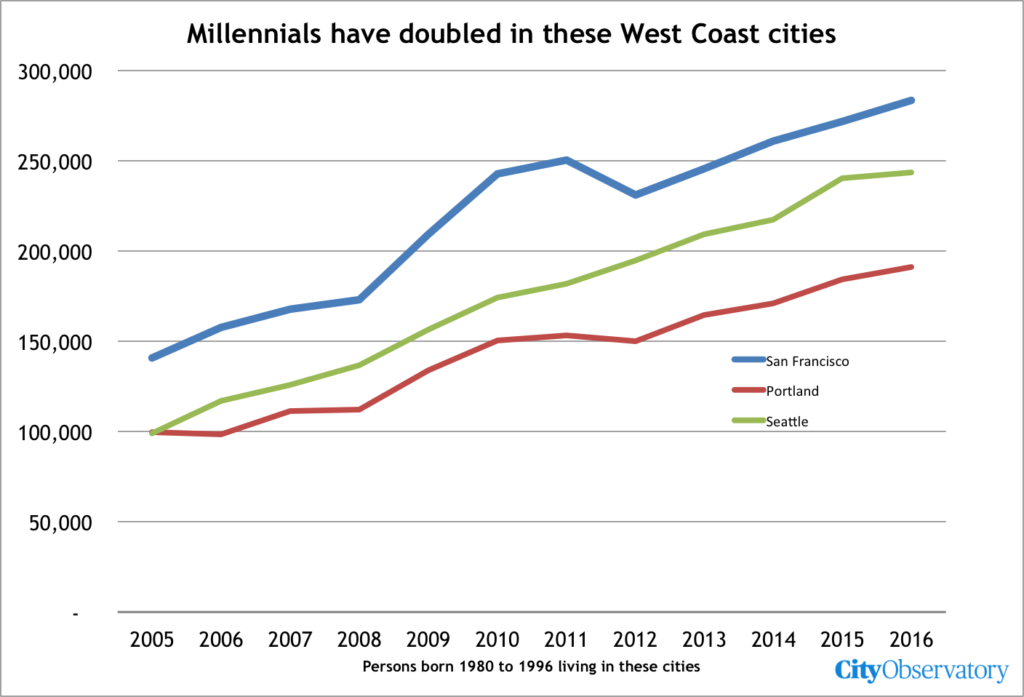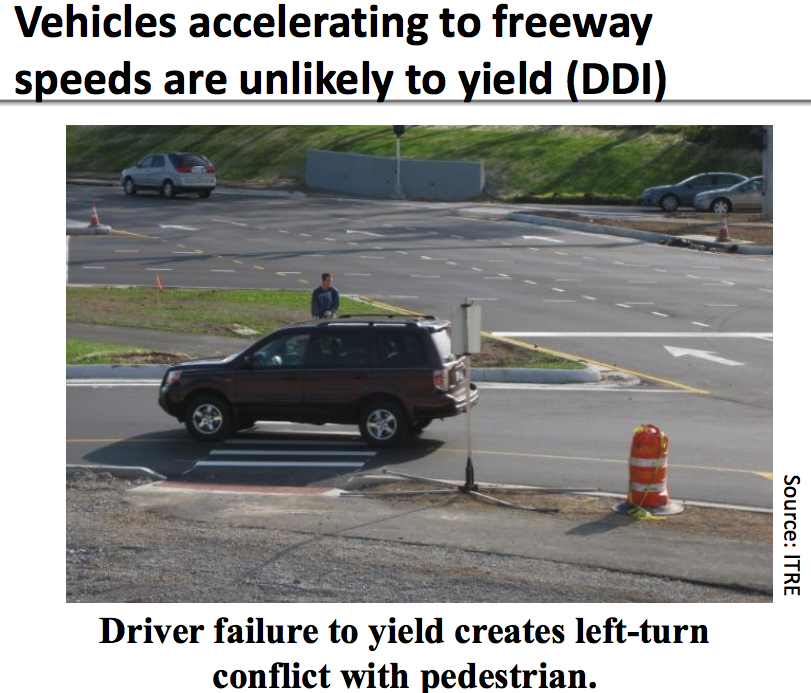What City Observatory did this week
1. Should cities be worried about “Peak Millennial?” Time magazine highlighted data from three cities where the count of millennials has declined in the past year, according to the American Community Survey. To some, it seems to be a harbinger that the young are growing disenchanted with city living. We challenge that interpretation. The focus on millennials (those born from 1980 to 1996, at least in this tabulation) misses the point that the number of young adults in the US (ages 25-34 will increase through the middle of the next decade and remain stable thereafter. The focus on millennials confuses lifecycle effects with true generational change. Our work and other studies confirm that young adults, especially those with college degrees, are much more likely that previous generations to choose city living.
2. Diverging diamond blues. Portland’s proposed half-billion dollar freeway widening project is pitched as a way of improving the pedestrian experience in the city’s Rose Quarter area. But one of the central design elements of the re-worked street system is a miniature “diverging diamond” interchange, which flip-flops the direction of traffic on a two way street (so cars are traveling on the left rather than the right side of the road). The purpose of the diverging diamond is to give cars a faster, straighter route to leaving the freeway. The combined result of these changes is the opposite of traffic calming: street crossings are made wider, with faster turn movements, plus pedestrians will be put in an environment where cars are coming from the opposite direction they expect. It’s hardly a recipe for pedestrian comfort or safety.
3. How the “G-word” is poisoning discussions of how to improve our cities. We offer a guest post from Akron planner Jason Segedy examining the way the term gentrification is invoked in the context of rustbelt cities. Especially in these struggling cities, he argues, “gentrification critics are holding cities to an unreasonable standard, and placing them in an impossible situation. If much of the city remains poor and run-down, this is proof that the city does not care, and is not trying hard enough. If, on the other hand, parts of the city begin to attract new residents and investment, this is proof that the city does not care, and is not trying hard enough. Heads I win. Tails you lose.” It’s time to figure out a way to talk about change that doesn’t make the perfect the enemy of the good, or at least the somewhat better.
Must read
1. The B-School case against Uber. Uber and its chief rival Lyft continue to grow, with more rides, riders, drivers and total sales. But the latest financial reports from Uber show that its still losing money, more than 1.5 billion in the latest quarter. Writing in Forbes, Len Sherman makes the case that there are irremediable flaws in the ride-hailing business model: it’s not becoming more productive as is grows, and its improvements in margin are coming primarily from squeezing driver compensation. The hoped for first mover advantages and network effects that the company and its investors were counting on to produce long-term monopoly-like profits, don’t appear to be materializing. At best, its locked in a fiercely competitive duopoly with Lyft that ensures profit-sapping competition for drivers on the one hand, and customers on the other. Uber can sustain continuing losses as long as its store of investor capital holds out, but as that dwindles, the future of this firm, and the future of the ride-hailing industry are unclear.
2. Five immutable laws of affordable housing. As we near the end of the year many of our colleagues are reflecting on the best work they published in 2017. Inexplicably, we missed this gem published at Strong Towns. Milwaukee’s Spencer Gardner describes what can fairly be regarded as the five immutable laws of affordable housing. We’ve reprinted them here in brief, but read the entire article to get a solid explanation. You’ll also find some useful thoughts on what it will take to make housing more affordable.
- Developers don’t pay the costs of construction; tenants and buyers do.
- Housing demand is regional.
- If your zoning and building code mandates expensive housing, housing will be expensive.
- Affordable housing isn’t affordable if your transportation costs are too high.
- Today’s affordable housing was the last generation’s luxury housing.
3. Demolitions aren’t shrinking the supply of affordable housing. One of the most frequently repeated arguments by opponents of new housing is that demolitions somehow reduce the supply of affordable housing and in their place build unaffordable units. A new study from Eve Bachrach, Paavo Monkkonen, and Michael Lens of the UCLA Luskin School tests that theory by looking at a random sample of developments in Los Angeles over the past three years. They find that, contrary to popular belief, post-demolition, these sites had both more total housing units and more affordable housing. Most of the demolitions are of single family homes, which are replaced with multi-family units, augmenting the housing supply. They conclude that demolitions are so small in scale as not to be having a significant negative effect on the supply of so-called “naturally occurring affordable housing.”
New knowledge
When did your city reach its peak ranking compared to other US cities?. Peak Charleston came in 1790, peak Buffalo was 1850, peak Minneapolis was 1890, peak Cleveland was 1920. Using historical census data and contemporary and consistent metropolitan area definitions, blogger peakbagger has shown how different cities have moved in and out, and up and down on the list of the nation’s 20 largest metropolitan areas over the past 220 years. You see clearly the westward shift in population and the waxing and waning of industries and technologies. Many cities that were historically important (Providence, Salem, Richmond and Albany) haven’t cracked the top 20 since the Civil War. The sunbelt cities-Dallas, Houston, Atlanta, Phoenix– only show up starting in the 1940s and later. In addition to a spaghetti chart showing the shifting ranks, you’ll also find decade by decade rankings and population estimates for the top 20 US metro areas.
In the news
Dan Horrigan, Mayor of Akron, cited our essay “Cursing the Candle” in his Beacon-Journal Op-Ed on his vision for the city’s future growth and revival.
The Salt Lake Tribune cites some of the key findings from our Young and Restless report in an article on efforts to attract and retain talented young workers in Salt Lake City.





